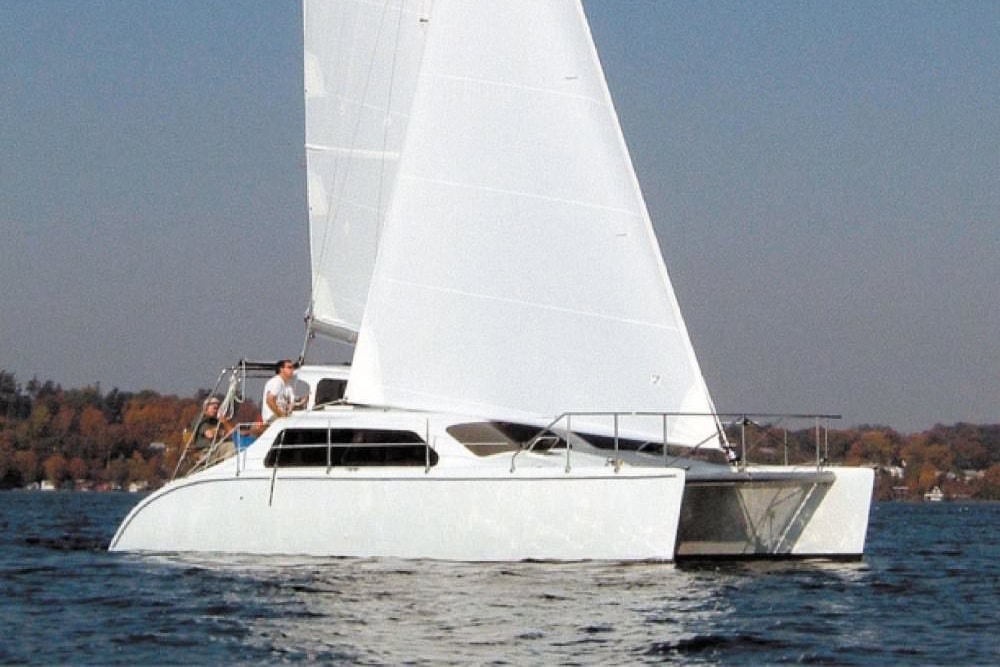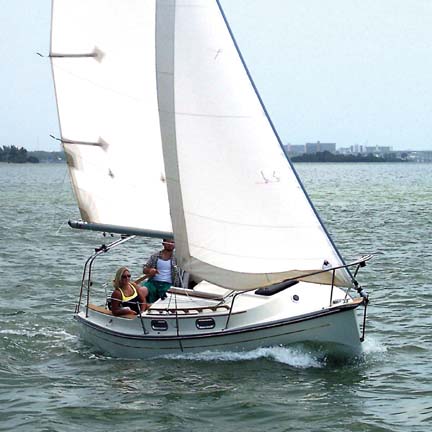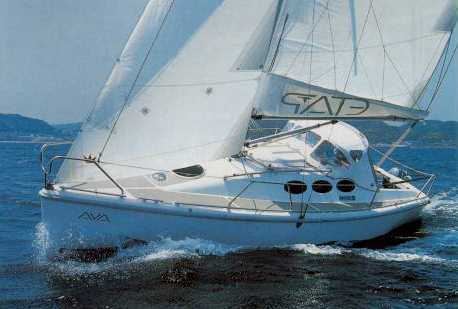
While many cruising sailors today jump with both feet and a hefty money clip into a big boat, chockablock with gadgetry, the traditional sailing evolution begins with small craft and ends with the ultimate cruiser. That first boat might be a dinghy or a one-design racer, and trading up from boat to boat usually accompanies changes in family situations and growing wealth. But no matter how big that überboat may be, cruisers with sailing in their blood usually find small craft compelling.
Small is usually simple. Getting off the mooring, the dock, or the dolly takes just minutes, allowing a spontaneous response to the siren call to savor a delicious, breezy fall sunset after work or a cool, still, summer dawn before joining rush hour.
But how big is small? That, of course, is relative. To establish “small” in terms of a cruising boat, as distinct from a daysailer, we chose as our guideline the European Union Recreational Craft Directive’s “Design Category C–Inshore (significant wave height up to and including 2 meters and wind forces up to and including 6 Beaufort).” A handful of new boats fell into that category, mostly candidates for Cruising World’s Boat of the Year 2005 contest that didn’t get nominated because they weren’t considered suitable for ocean passages.
The U. S. Sailboat Show in Annapolis, Maryland, offered the best opportunity to take a look at some of them conveniently close to one of the largest contiguous bodies of Category C water in North America: Chesapeake Bay.
A Compact Cat
Even though, at 32 feet, the TomCat 9.7 was the biggest vessel in the group, builder Ted Strain makes no bold claims about its capabilities. “I expect to see this boat on lakes, inland waters like Chesapeake Bay, and on inshore cruises,” he says. “It’d be an ideal boat for the Abacos.” Although the hulls are only three feet wide at sole height, artful use of the interior and the bridgedeck creates the generous accommodations typical in catamarans. Head (to port), galley (to starboard), and sleeping quarters (in both sterns) occupy the hulls, which are stepped aft to accommodate 48-inch-wide double berths. A large athwartships playpen berth and an adjoining “dining booth” make full use of the “house.” Aft of the dinette is a vestibule with full standing headroom that’s open to the cockpit but can be closed with a set of detachable panels. The builder, Strain Associates Ltd./TomCat Boats, offers a choice of woods for the interior finish and also entertains modifications to the interior layout to accommodate customers’ preferences.
To simplify construction, to avoid having daggerboard housings take up space in the narrow hulls, and to make sailing easier, Strain designed the TomCat with a centerboard deployed from the bridgedeck. Neatly tucked under the saloon table, its housing ties into the massive structural focal point of mast step and main beam. When raised to the draft of the hulls, the board still has some bite in the water, which helps when sailing to weather in shallow water.
Although Strain deliberately kept the sail plan small to assuage safety concerns about catamarans that he says still persist in the general sailing community, it’s adequate to push the boat along in as little as 7 knots of wind. The TomCat also tacked handily in this light air, as long as the skipper was paying attention and had the boat moving before turning the wheel. Auxiliary power is provided by outboards mounted on each transom, and rather than develop a unique helm system for the twin rudders, Strain adapted outboard-motor steering controls that have been in use for many years and are available off the shelf in marine stores everywhere.
A roller-furling jib and lazy jacks on the main simplify sailhandling, and the stainless-steel arch keeps the traveler aloft and out of the way. Backseat drivers can observe and critique the helmsman’s work from a bench seat beneath this arch.
I found the side decks too narrow for even small feet and would happily trade a little interior headroom for an inch or two more footing. You can go forward across the cabin top; however, that enterprise would be easier and safer with a grabrail on the house.
Strain, who runs TomCat Boats with his son Tom, came late to boatbuilding–he’s a physicist and electrical engineer by profession–but he’s familiar with the pros and cons of catamarans because, he says, the Iroquois he’s owned for 34 years has its share of both. Strain is full of praise for the Iroquois’ designer, Rod McAlpine-Downey. “He was years ahead of his time,” he says.

For the Road and Ramps
Slipping in at the low end of the size spectrum comes the Eclipse from Com-Pac Yachts/The Hutchins Company, long a favorite builder of neat, compact cruisers. The Eclipse, 21 feet LOA, is a rare new model in its lineup. In a break from tradition for a firm that does much of its development work in-house, Hutchins sought input from naval architect Bruce Bingham. The move seems to have paid off. Bingham helped with the boat’s styling, contributing the plumb stem and a stretched-out waterline, making the most of the boat’s short length for both speed potential and interior volume.
While some folks will happily gunkhole in even smaller craft, the Eclipse, at just over 18 feet on deck, is about as large a boat as you’d want to trailer behind a midsize car but as small a one as will still accommodate civilized living. Making such tight quarters livable requires deliberate and careful design of every corner and component. Lift a cushion here, you reveal the galley sink; lift another, and there’s the stove; flip the countertop between them and set the stove into the braces on its underside, which is now on top.
Most of the Eclipse’s interior consists of cushioned horizontal surfaces, so the feeling is reminiscent of being in a playpen. While there’s ample room for sprawling or sitting comfortably, thanks to the centerboard trunk being under the sole, headroom is elusive. If you want to stretch your legs, stand in the hatch. But it’s really cozy in the cabin, and I can envisage being tucked up a shallow creek and burrowing into a good book while gentle rain patters on the deck and an aromatic stew simmers on the stove.
When the clouds blow away, the Eclipse is ready for action, which it takes seriously. The rudder kicks down, and the centerboard drops out of the shallow molded keel to a weatherly draft of 5 feet 2 inches. The boat has a very flat bottom and soft chines that carry the waterline beam well outboard for added stability. The mainsheet is raised above the cockpit on a stainless-steel arch, which also serves as an attachment point for a bimini, as boom gallows, and as mast support for trailering. The mainsheet leads forward along the boom, then back to the cockpit to a cleat on the cabin top. An optional outboard motor can be mounted on a transom bracket, while the gas tank stows neatly away in the starboard cockpit locker.
Taking its cue from the big charter boats, the Eclipse’s open transom provides easy access from cockpit to creek and easy egress up a fold-down stainless-steel ladder.
The transition from sailer to trailer is simple and can be accomplished singlehandedly, if necessary. Key to that is the trademarked Mastendr system, which includes a pinned mast hinge just above the furled mainsail, quick-release levers for de-tensioning standing rigging, and a stainless-steel gin pole that provides the lever for lowering the spar. Once it’s resting on the stern arch, the mast can be unpinned from its hinge and slid forward to balance the overhangs on the trailer.
Even as access to the water becomes more scarce for larger boats, ramps still provide a way in for boats on wheels, and those boats are usually of light enough draft that they can sail in the less deep and less crowded waters. Looking at this Eclipse, the light of this approach is almost blinding.

Fair and Fast
While the Eclipse is unabashedly small, the Etap 24i has pretensions to sailing in a bigger pond with bigger fishes. With the standard 4-foot-11-inch keel, the boat is European Union certified for Category B.
Like all the Etaps, it’s unsinkable, which means the unthinkable won’t happen even if the big pond turns nasty or things go terribly wrong. However, the 24i approaches the business of sailing with considerable pluck and instills confidence that it can handle boisterous conditions. It’s the kind of vessel in which British or French sailors would cheerfully cross the English Channel on a weekend.
For those who sail in Category C waters on this side of the Atlantic, the Etap 24i has another great advantage: Its optional tandem keel draws less than 3 feet while it still helps the boat sail well to windward, making the vessel doubly attractive to sailors in shallow-water venues. On our afternoon outing on Chesapeake Bay, in a gentle fall breeze, we sailed five miles closehauled from the Eastern Shore root of the Bay Bridge to the Severn River, posed there for the photographer, and reached back all in well under three hours. The Etap 24i evidently has the legs for serious coastal cruising.
The crew’s body weight is important trimming ballast on a small cruiser like the Etap 24i. Using the tiller extension and sitting on the artfully angled cockpit coaming not only gives you better visibility and more comfort but it also puts you farther out on the rail to give the boat more power. The twin rudders have plenty of bite and permit the outboard to be mounted on centerline. An inboard 10-horsepower Yanmar with a saildrive is a good option if you’re concerned about weight distribution or your aging back’s capacity for handling a hefty four-stroke on the stern.
Belowdecks, too, the 24i reveals big-boat aspirations–a plumbed-in toilet and holding tank suggest it’ll go beyond a portapotti’s operating radius. It also has a stainless-steel sink and surround for the two-burner Origo alcohol stove. The forward cabin can be closed off, though that might make it a little claustrophobic and a little too intimate with the head. The saloon has a lot of cushioned areas, and removable backrests convert the settees into real berths.
Abovedecks, the emphasis Etap places on thoughtful design is evident in the simple sweeping transition from coachroof to cockpit coaming and in the aluminum toerail extrusion. Another clever detail is the removable mainsheet traveler that opens the cockpit for more après-voile leisure space.
With its beam a smidgen under 8 feet 3 inches, the Etap 24i is legally trailerable, which expands your cruising options from Category C to category lake, or river.
The Hunter in the Pack
Even if you can’t have–or don’t want–a big boat, you can have big-boat stuff. At least that’s the message Hunter Marine is sending with the new Hunter 27, especially when it’s tricked out with the Deluxe Package.
Right down to the shore-power supply, the half-electric/half-butane two-burner stove, the microwave, and the 12-volt cooler that you load at home and stow in a specially built drawer in the galley, this boat is equally well equipped for life at the dock and for sorties to nearby cruising grounds.
The Hunter design team came up with a boat that fits the niche of a 27-foot sailboat for novices who want stability, ease of operation, and value. With leisure time being a rare commodity for most folks, a Category C venue is about as far as most will get on the spur of a moment before it’s time to head back. The Hunter provides a means to enjoy such moments in comfort.
For anyone whose experience in 27-footers is determined by boats like the Bristol 27 of the 1960s–me, for one–the Hunter 27 offers a new yardstick. Thanks to its plumb stem, long waterline, broad beam, and high freeboard, there’s elbow room everywhere the older boats lack it: in the V-berth (in this layout, essentially an extension of the saloon), the saloon (with comfortable seating for at least six around a central table), the head (complete with shower), and the galley. In addition, the Hunter provides an aft cabin complete with a hanging locker, a seat, and a huge athwartships berth under the cockpit–all wrapped into a package with crisp and attractive lines.
An inboard engine, a 9-horsepower Yanmar, is standard, and access to it is generous, particularly from the front: The companionway steps hinge up, their weight taken by gas struts, to reveal most of the maintenance points and a water heater for the shower.
The Hunter 27 is also quite nicely equipped for sailing. The mainsheet is double-ended–one end with a 3:1 purchase for quick trimming, and the other with a 6:1 ratio for fine-tuning–and the cockpit is laid out for easy singlehanding. The standard rig is a fractional B&R arrangement with optional in-mast furling.
Another big-boat feature is the wheel steering. At 27 feet, the boat is at the margin between the practicality of a tiller and the comfort of a wheel, but Hunter insists the market has embraced wheel steering, so a wheel it is. The optional Lewmar folding wheel further improves access to the walk-through transom, but it’s pushed so far aft to open up the cockpit that the stern lifeline interferes with the helm seat. As on all Hunters, back-seat drivers can second-guess the skipper from perches in the corner pushpits, but they’d better not be too critical, as guest spots on this boat will be easy to fill.
Given the trend among builders in recent years to bring out ever bigger boats, it’s encouraging to know that the market for pocket cruisers remains vibrant enough to produce such a variety of practical, fun, and versatile craft.
Jeremy McGeary is Cruising World’s senior editor.
SPECS
Com-Pac Eclipse
LOA 18′ 5″ (5.61 m.)
LWL 18′ 1″ (5.51 m.)
Beam 7′ 4″ (2.23 m.)
Draft 1′ 6″ /5′ 2″ (.46/1.57 m.)
Sail Area(100%) 200 sq. ft. (18.6 sq. m.)
Ballast 700 lb. (318 kg.)
Displacement 2,200 lb. (1,000 kg.)
Water 5 gal. (19 l.)
Fuel 6.5 gal. in portable tank (25 l.)
Engine Outboard (optional)
Designer Com-Pac Yachts
Price $23,000
Com-Pac Yachts
(727) 443-4408
www.com-pacyachts.com
Etap 24i
LOA 23′ 11″ (7.30 m.)
LWL 22′ 0″ (6.71 m.)
Beam 8′ 2″ (2.50 m.)
Draft (Standard/tandem keel) 4′ 11″/2′ 9″ (1.5/.85 m.)
Sail Area(100%) 277 sq. ft. (25.6 sq. m.)
Ballast (Standard/tandem keel) 1,100/1,144 lb. (500/520 kg.)
Displacement (Standard/tandem keel) 3,960/4,004 lb. (1,800/1,820 kg.)
Water 13.15 gal. (50 l.)
Fuel Optional; 8 gal. (30 l.)
Engine 10-hp. Yanmar inboard diesel (optional) or outboard
Designer Marc-Oliver von Ahlen, Etap Yachting N.V.
Price $60,000
Etap USA
(866) 382-7872
www.etap-usa.com
Hunter 27
LOA 27′ 4″ (8.33 m.)
LWL 23′ 7″ (7.19 m.)
Beam 9′ 11″ (3.02 m)
Draft (Shoal/deep) 3′ 5″/5′ 0″ (1.04/1.52 m.)
Sail Area(100%) 298 sq. ft. (27.6 sq. m.)
Ballast (Shoal/deep) 2,052/1,901 lb. (930/861 kg.)
Displacement (Shoal/deep) 7,656/7,505 lb. (3,480/3,411 kg.)
Water 20 gal. (76 l.)
Fuel 15 gal. (57 l.)
Engine Yanmar 9 hp. (base); 18 hp. (deluxe)
Designer Glenn Henderson and Hunter Marine Design Team
Price $51,000 (base), $57,000 (deluxe)
Hunter Marine Corporation
(386) 462-3077
www.huntermarine.com
TomCat 9.7
LOA 32′ 0″ (9.75 m.)
LWL 31′ 6″ (9.60 m.)
Beam 16′ 0″ (4.88 m.)
Draft (Board up/down) 1′ 6″/5′ 0″ (.46/1.52 m.)
Sail Area(100%) 417 sq. ft. (38.8 sq. m.)
Ballast NA
Displacement 4,800 lb. (2,182 kg.)
Water 35 gal. (133 l.)
Fuel 24 gal. (91 l.)
Engine Two Yamaha 9.9-hp. four-stroke outboards
Designer Ted Strain
Price $130,000
TomCat Boats
(905) 584-1236
www.tomcatboats.com








